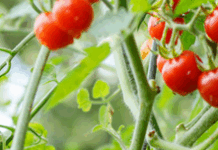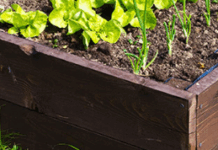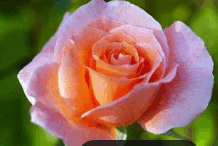1712 Claflin, 2021 Throckmorton Plant Science Center
Manhattan, KS 66506 (785) 532-6173
Download and print the Hort Newsletter
(Downloadable version)
HNR Website access: https://hnr.k-state.edu/extension/horticulture-resource-center/horticulture-newsletter/
VIDEO OF THE WEEK:
K-State Garden Hour
Preserve it Fresh, Preserve it Safe
If your garden is overflowing with fresh produce, what will you do with it? Besides enjoying the fresh flavors or sharing with family and friends, preserving the produce for later use is a great way to enjoy that taste of summer later in the year. Learn some easy ways to safely preserve your food.
GARDEN TO-DO
Avoid fertilizing ornamentals now so they harden off before winter
Take cuttings from cold-sensitive annuals to root for wintering indoors. See: https://kansashealthyyards.org/all-videos/video/cuttings-to-grow-inside-for-winter
Turn compost pile and add water when dry
TURF
Reading Grass Seed Labels
Before planting grass seed pay close attention to the percentages on the label. Depending on the seed quality, you could be planting weeds along with the desired grass.
Check the percentage of weed seed listed. This will tell you how much weed you will be introducing if you plant this seed mix. For example, if this number is 0.5% weed seed, approximately 12 to 16 weeds will be planted per square foot. If it is less than 0.01% weed seed that is good but 0% is best.
Check “Other Crop” on the label as well and choose a grass seed with a low percentage. “Other Crop” includes any species grown intentionally such as turfgrasses and pasture grasses. Some species of grassy weeds fit into this category and legally do not have to be named when they’re included in a mix if they constitute less than 5% of the contents. “Other Crop” can also include more desirable species that will not significantly impact your lawn. Without knowing what is included it’s best to choose a seed where this number is as close to zero as possible. Quality seed typically has 0.01% “Other Crop” or less.
VEGETABLES
Anthracnose of Tomatoes
Description: High humidity and frequent rainfall favor development of the fungal disease, anthracnose. Most often seen in the later part of the growing season on ripe fruit, anthracnose reduces the quality and yield of the tomato harvest.
Damage: Symptoms begin as small, circular lesions that are slightly depressed on the surface of the fruit. Spots grow both in diameter of the circles and the depth of the depressions. The sunken lesions give a water-soaked appearance beneath the skin of the fruit. During humid weather, the fruiting structures release buff-colored fungal spores (conidia). As lesions grow, they can join and cause the fruit to decay which promotes microorganisms to invade and rot the fruit entirely.
Control: Anthracnose spores survive in plant debris and soil. Spores can get splashed onto fruit during a heavy rain or even with overhead watering. This continues the spread of the disease. Follow proper cultural practices for prevention. Use mulch over the soil around tomato plants and remove plant debris from the ground. Promote air flow to reduce humid conditions by staking the tomato plants. Use drip irrigation or a soaker hose to prevent splashing spores onto plants.
Why Aren’t My Tomatoes Ripening?
Most gardeners are salivating over garden fresh tomatoes. I’ve watched my tomatoes developing and it seems to have taken twice as long this year to get ripe fruit from my plants.
If the plants are otherwise healthy and you’re still waiting for fruit to ripen, or it is happening slower than expected, it may be the result of temperature. Tomatoes ripen best when the temperature ranges between 70- and 75-degrees F. Ripening can slow or even halt when the temperature rises above 90 degrees F.
If you’re feeling impatient, you can remove fruit that has started to show the first signs of color change and ripen them indoors, at room temperature, in the dark. The more enclosed the fruit is (such as in a paper bag) the quicker it will ripen due to the exposure to ethylene gas.
FLOWERS
Spring-Flowering Shrubs
Spring-flowering shrubs typically establish buds for next year in August and September. Avoid pruning these shrubs now as it will negatively affect next year’s bloom. Water, as needed, this time of year to support the plants’ new growth.
Examples of spring-flowering shrubs include Forsythia, Flowering Quince, Almond, Beautybush, Deutzia, Pyracantha, Lilac, Mock Orange, Cotoneaster, Weigela, Viburnum and Witch hazel.
TREES
Mulch Rings Around Trees
A mulch ring is a circular border surrounding the base of a tree. Recommendations for proper tree planting include a mulch ring that covers the soil beneath the tree canopy.
One benefit of using a mulch ring around trees in a lawn area is to prevent maintenance equipment from coming too close and damaging the trunk. Plants grown directly beneath the tree canopy compete for water and nutrients. A mulch ring keeps the soil covered without creating competition.
Use organic mulch, if possible, for the same reasons it is selected for planter beds in general. The mulch ring around trees in a lawn should be at least three to six feet in diameter depending on the overall size of the tree. Ideally the mulch ring should extend to the drip line of the tree. This means the ground beneath the entire canopy of the tree should be covered protecting the majority of the plant roots.
Create a flat, donut-shaped ring of mulch around the tree leaving a 4–6-inch diameter circle of bare soil at the center so mulch isn’t right up next to the trunk to prevent rotting. The mulch should be 2-4 inches deep and reapplied annually. If applied too deep (more than four-inches) the mulch can actually restrict oxygen from the soil and negatively affect root development.
PESTS
Fall Armyworms
Though often found in agricultural crops, fall armyworms can be present in certain turfgrass species and we’ve had a few reports of them recently.
Description: Young larvae are ½ to ¾ inches long. Mature larvae can reach 1½ inches long. Fall armyworms can be identified by the inverted “Y” on top of the dark head. Adult moths are ½ inch long. The two front wings are brown-grey. Males have more dark markings than females.
Life Cycle: As a tropical insect, fall armyworms are not able to overwinter in Kansas limiting them to 2-4 generations each year. Moths migrate to their seasonal home and lay hundreds of eggs in clusters. Larvae hatch and begin feeding. Once established, new generations can occur every 23-25 days.
Damage: Larvae feed on grass blades. Heavy infestations will occasionally chew the blades to the crown. Though the damage may be unsightly it does not typically kill the grass. Regrowth of the turfgrass can be expedited with rain and/or irrigation.
To read more about fall armyworm and control options access our publication from the Horticulture Resource Center: Fall Armyworm.
Learn more from K-State Entomology: Fall Armyworm.
MISCELLANEOUS
Composting: What to Add
The most efficient compost has the right combination of carbon (browns) and nitrogen (greens) ingredients. Examples of browns include dried items such as leaves, twigs, straw, wood chips and sawdust. It is best to chop up the dried materials to expedite decomposition.
Examples of greens are coffee grounds, egg shells, fruit/vegetable scraps and fresh plant parts. Manure from farm-type animals (cows, sheep, etc.) is another green waste that can be added. Pet waste should not be used in compost.
Layer the compost pile alternating between six to eight inches of brown waste and two to three inches of green waste until the pile reaches three to five feet tall. You can wet down each layer of “browns” as you build the pile. This combination of materials creates an ideal environment for microorganisms that promote decomposing.
Should I Compost My Tomato Plants?
There are some common problems that occur with tomatoes which can easily spread to next year’s garden if the compost heap does not reach adequate temperatures for a long enough period of time to kill the spores. A compost pile that is not properly balanced with the amount of greens and browns and/or one that is not maintained to promote air circulation will not decompose as quickly. If compost is used before it is fully decomposed, diseases can easily spread to the plants it is supposed to be supporting.
If you suspect, or know, your current plants are harboring a disease, it is safest to destroy them when they have finished producing, rather than composting them.
QUESTION of the WEEK
What’s happening to the bark on my tree?
We are finding bark pieces on the ground beneath a mature tree in our yard. There are sections on the branches where the bark is stripped away. Any ideas what is causing this?
This looks like damage caused by squirrels. This kind of damage can sometimes cause girdling resulting in branch die-back. For recommendations, contact your local extension agent or read our KSRE Publication: Squirrel Damage to Trees
Contributors:
Cynthia Domenghini, Instructor and Horticulture Extension Specialist
Judy O’Mara, Plant Pathology Diagnostics Lab
K-State Turfgrass Blog
K-State Extension Entomology
K-State Wildlife and Outdoor Enterprise Management
Division of Horticulture
1712 Claflin, 2021 Throckmorton
Manhattan, KS 66506
(785) 532-6173
For questions or further information, contact your local extension agency.
This newsletter is also available on the World Wide Web at:
http://hnr.k-state.edu/extension/info-center/newsletters/index.html
The web version includes color images that illustrate subjects discussed. To subscribe to this newsletter electronically, send an e-mail message to cdom@ksu.edu or cdipman@ksu.edu listing your e-mail address in the message.
Brand names appearing in this newsletter are for product identification purposes only. No endorsement is intended, nor is criticism implied of similar products not mentioned.
K-State Research and Extension is committed to making its services, activities and programs accessible to all participants. If you have special requirements due to a physical, vision or hearing disability, or a dietary restriction please contact Extension Horticulture at (785) 532-6173.
Cynthia Domenghini, Ph.D.
Instructor; Horticulture Extension Specialist
Department of Horticulture and Natural Resources
Kansas State University
1712 Claflin Rd.
Manhattan, KS 66503
785-340-3013
cdom@ksu.edu
Access the HORTNEWS-L Home Page and Archives
Unsubscribe from the HORTNEWS-L List





